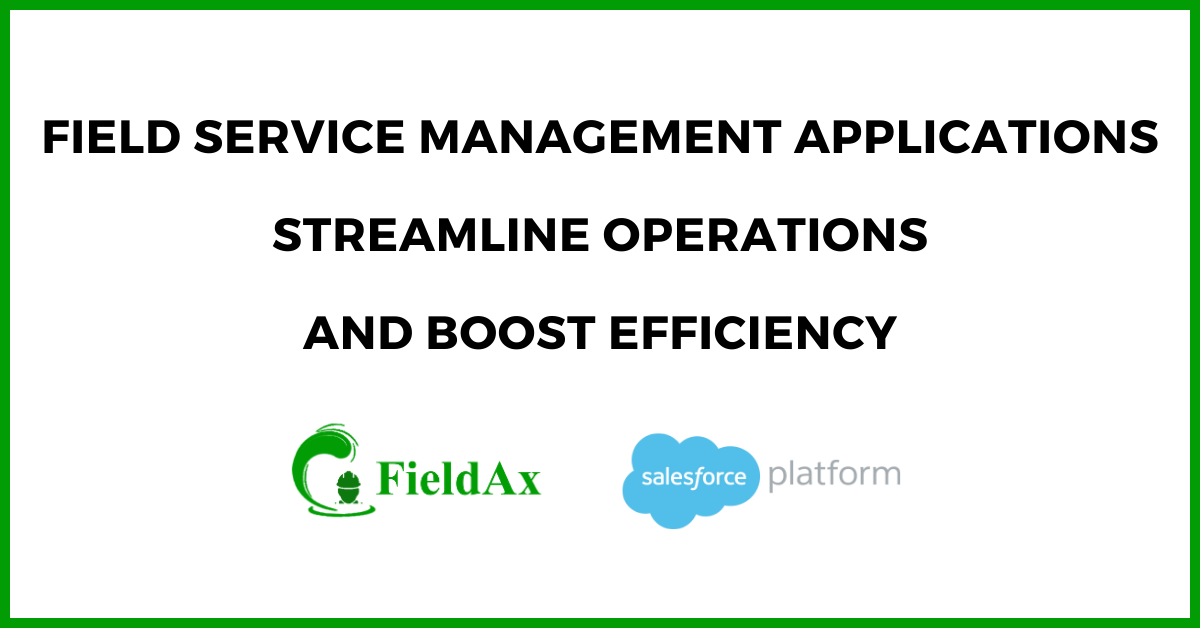Welcome to our article that delves into the world of field service management applications. In today’s fast-paced business landscape, managing field services efficiently is crucial for small and medium-sized businesses (SMBs) to thrive and stay competitive. But what exactly are field service management applications, and how can they benefit your organization?
Field service management applications are powerful software solutions designed to streamline and optimize the day-to-day operations of businesses that rely on field services to deliver products or services to their customers. These applications centralize and automate various processes, such as scheduling, dispatching, inventory management, and customer communication, ultimately enhancing productivity and customer satisfaction.
In this article, we will explore the importance and benefits of implementing field service management applications for SMBs. We will discuss how these applications can help you overcome common challenges, like inefficient scheduling, poor visibility into field operations, and limited data analysis capabilities. Additionally, we will provide insights into the key features to look for when selecting a field service management application, and how to ensure a successful implementation.
Join us on this journey as we uncover the immense value that field service management applications can bring to your SMB. Discover how empowering your field service workforce with the right tools can revolutionize your operations, drive growth, and ensure a seamless experience for your customers.

Benefits of Field Service Management Applications for SMBs
A. Increased Efficiency and Productivity
- How field service management applications streamline workflows
Field service management applications help SMBs streamline their workflows by automating various tasks and processes. This reduces the need for manual intervention and allows for more efficient operations.
- Automating manual tasks and reducing paperwork
With a field service management application, SMBs can automate manual tasks like data entry, scheduling, and reporting. This not only saves time but also reduces paperwork, leading to improved productivity.
- Optimizing service scheduling and dispatching
By using a field service management application, SMBs can optimize their service scheduling and dispatching processes. This ensures that the right technician is assigned to the right job at the right time, improving efficiency and customer satisfaction.
B. Enhanced Customer Satisfaction
- Improving communication and response times
A field service management application enables SMBs to improve communication and response times with their customers. Through features like real-time updates and notifications, businesses can keep their customers informed about the status of their service requests.
- Providing real-time updates to customers
SMBs can provide real-time updates to their customers using a field service management application. This helps to build trust and transparency by keeping customers informed about the progress of their service appointments.
- Personalizing customer experiences with relevant information
A field service management application allows SMBs to personalize customer experiences by providing technicians with relevant information about the customer and their past service history. This helps them deliver more tailored and efficient service.
C. Cost Savings and Return on Investment (ROI)
- Analyzing the financial impact of field service management applications
SMBs can analyze the financial impact of field service management applications by measuring cost savings and return on investment. These applications help businesses reduce operational costs and improve profitability through increased efficiency and productivity.
- Reduced operational costs and increased profitability
Field service management applications help SMBs reduce operational costs by eliminating manual processes, minimizing errors, and optimizing resource allocation. This leads to increased profitability and a higher return on investment.
- Case studies showcasing cost savings through automation and optimization
Several case studies highlight the cost savings achieved by SMBs through the automation and optimization capabilities of field service management applications. These success stories demonstrate the potential financial benefits for businesses.
Key Features to Consider When Choosing a Field Service Management Application
When selecting a field service management application for your business, it’s essential to consider the key features that will meet your specific needs and requirements. By understanding these features, you can ensure that the application you choose will streamline your workflow and improve efficiency. Here are the key features you should consider:
A. Service and Customer Management
- Managing customer information and preferences: An effective field service management application should enable you to store and access customer details, including their contact information and any specific preferences they may have.
- Tracking service history and customer interactions: It’s crucial to have a system that captures and organizes the service history and interactions with your customers, allowing you to provide personalized and efficient service.
- Enabling self-service options for customers: A valuable feature is the ability for customers to access self-service options, such as online appointment booking or requesting service directly through the application.
B. Field Service Scheduling and Dispatching
- Efficiently assigning and routing technicians: The application should have advanced scheduling capabilities to assign the right technician to the right job, considering factors such as skills, location, and availability.
- Real-time visibility into technician availability and location: Having real-time visibility into your technicians’ availability and their current location allows for better scheduling and dispatching decisions.
- Optimizing schedules based on priority and geography: The application should be able to optimize schedules based on priority and proximity, minimizing travel time and ensuring efficient service delivery.
C. Workflow and Process Automation
- Streamlining administrative tasks and approvals: Look for an application that automates administrative tasks, such as generating work orders or obtaining approvals, to reduce manual effort and improve productivity.
- Automating work order creation and updates: A field service management application should automate the creation and updating of work orders, ensuring accurate and up-to-date information for technicians.
- Integrating with existing business systems for data exchange: Seamless integration with your existing business systems allows for smooth data exchange and eliminates the need for manual data entry.
D. Reporting and Analytics
- Tracking key performance metrics and service levels: The application should provide comprehensive reporting capabilities, allowing you to monitor key performance metrics and service levels to identify areas for improvement.
- Generating reports on technician productivity and customer satisfaction: Detailed reports on technician productivity and customer satisfaction enable you to make data-driven decisions to enhance performance and customer experience.
- Using data insights to make informed business decisions: An effective field service management application should provide actionable insights from the data collected, empowering you to make informed business decisions.
By considering these key features when choosing a field service management application, you can ensure that the solution you select aligns with your business objectives and enhances your overall field service operations.
Best Practices for Implementing and Adopting Field Service Management Applications
Importance of proper planning and change management
Implementing a field service management application requires thorough planning and effective change management. It is crucial to assess your organization’s current processes, identify areas for improvement, and set clear goals and objectives before implementing the application.
By taking the time to understand your business requirements and aligning them with the functionalities of the application, you can ensure a successful implementation that addresses your specific needs.
Ensuring buy-in from stakeholders and end-users
For a field service management application to be truly successful, it is vital to obtain buy-in from all stakeholders and end-users. This includes management, field technicians, customer service representatives, and any other team members involved in the field service process.
Prior to implementation, communicate the benefits and advantages of the application to the stakeholders. Address their concerns and address any potential resistance to change. Involving them in the decision-making process and showcasing how the application can streamline operations and improve efficiency will increase the chances of successful adoption.
Training and ongoing support for successful adoption
To ensure a seamless transition and successful adoption of the field service management application, proper training and ongoing support are essential.
Provide comprehensive training sessions for all users, covering the application’s functionalities and best practices. Offer additional resources such as user manuals or online tutorials for reference. Encourage users to ask questions and provide ongoing support to address any issues or concerns that may arise.
Regularly monitor the usage of the application and provide feedback and coaching to users to enhance their knowledge and skills. This will go a long way in maximizing the benefits of the field service management application and promoting its effective adoption across your organization.
Integrating Field Service Management Applications with Existing Business Systems
Integrating your Field Service Management (FSM) application with your existing business systems can unlock a plethora of benefits for your SMB. However, it is not without its challenges. In this section, we will delve into overcoming these integration obstacles and explore the common integration points with CRM, ERP, and other systems. We will also highlight the advantages of real-time data synchronization and centralized information.
Overcoming challenges of integration
Integrating FSM applications with existing business systems may pose certain challenges, but they can be overcome with the right approach. One of the key hurdles is ensuring compatibility between different systems, such as CRM and FSM. It requires a deep understanding of the integration process and adherence to industry standards. By partnering with a reliable FSM provider that offers seamless integration solutions, you can navigate these challenges with ease.
Common integration points with CRM, ERP, and other systems
When integrating FSM applications with existing business systems, it is essential to identify the common integration points. Integration with CRM enables a streamlined flow of information, ensuring customer data is up to date and accessible in real time. Integrating FSM with ERP facilitates seamless coordination between field operations and back-office functions. Other systems, such as inventory management or billing software, can also be integrated to enhance productivity and efficiency.
Benefits of real-time data synchronization and centralized information
Real-time data synchronization is a game-changer for SMBs leveraging FSM applications. It allows field technicians to have access to the latest information and updates on client requests, inventory availability, and scheduling changes. This real-time visibility enables better decision-making, reduces errors, and improves overall customer satisfaction. Moreover, centralized information ensures that everyone in your organization is working with the same accurate data, eliminating any discrepancies or misunderstandings.
Top Field Service Management Applications for SMBs
When it comes to managing your field service operations efficiently, having the right software in place can make all the difference. Here, we will provide a brief overview and comparison of some of the leading field service management software available for small and medium-sized businesses.
Salesforce Field Service Lightning
Salesforce Field Service Lightning is a comprehensive field service management application that offers a wide range of features to help SMBs streamline their operations. With its intuitive user interface and powerful capabilities, this software allows businesses to schedule, dispatch, and track field technicians effortlessly. It also offers real-time visibility into field activities, enabling businesses to optimize their resource utilization and improve customer satisfaction.
Key Features:
- Scheduling and dispatching capabilities
- Real-time tracking and reporting
- Mobile access for technicians
- Integration with other Salesforce applications
- Customizable workflows
Pricing: Contact Salesforce for pricing details.
Scalability Considerations: Salesforce Field Service Lightning is highly scalable and can accommodate the growing needs of SMBs.
ServiceMax
ServiceMax is another popular field service management application that helps SMBs optimize their field operations. With its advanced features and intelligent capabilities, this software enables businesses to automate their work processes, streamline workflows, and enhance productivity. ServiceMax also provides comprehensive analytics and reporting, allowing businesses to gain valuable insights into their field service performance.
Key Features:
- Work order management
- Inventory tracking
- Contract management
- Asset and warranty management
- Mobile access for technicians
Pricing: Contact ServiceMax for pricing details.
Scalability Considerations: ServiceMax is designed to scale with the growth of SMBs, ensuring that businesses can continue to leverage its capabilities as their operations expand.
FieldAx
FieldAx is a comprehensive field service management application specifically designed for SMBs. With its user-friendly interface and robust features, FieldAx helps businesses improve their field service efficiency and customer satisfaction. This software offers a wide range of functionalities, including work order management, scheduling, dispatching, inventory tracking, and billing. FieldAx also provides real-time updates and notifications, enabling businesses to stay informed about their field operations at all times.
Key Features:
- Work order management
- Scheduling and dispatching capabilities
- Real-time updates and notifications
- Mobile access for technicians
- Integrated billing and invoicing
Pricing: FieldAx offers affordable pricing plans tailored to the needs of SMBs. Contact FieldAx for detailed pricing information.
Scalability Considerations: FieldAx is designed to scale with SMBs, allowing businesses to add more users and expand their operations without any hassle.
For guidance in the selection process, it is also beneficial to consider customer reviews and ratings. Hearing from other SMBs who have used these field service management applications can provide valuable insights into their experiences and help inform your decision-making process.
You are one click away from your customized FieldAx Demo!
Book Demo
Case Studies Showcasing Successful SMBs Utilizing Field Service Management Applications
Real-world examples of small and medium-sized businesses (SMBs) that have successfully implemented field service management applications are a testament to the power and effectiveness of these software solutions. By leveraging the right tools, these SMBs have transformed their operations, improved customer satisfaction, and achieved impressive business outcomes.
Highlighting the Benefits, Challenges Faced, and Outcomes Achieved
These case studies provide valuable insights into the benefits, challenges, and outcomes of using field service management applications. They demonstrate how these applications can:
- Optimize scheduling and dispatching: By automating and streamlining the scheduling and dispatching processes, SMBs can ensure that their field service teams are efficiently utilized, resulting in faster response times and improved service quality.
- Increase workforce productivity: With features like mobile access, real-time updates, and automated workflows, field service management applications enable SMBs to empower their field technicians, effectively manage their resources, and maximize productivity.
- Enhance customer experience: By providing accurate and real-time information to both the field technicians and customers, these applications enable SMBs to deliver exceptional customer service, increase customer satisfaction, and build long-term relationships.
- Improve operational efficiency: Automation of manual processes, centralized data management, and integration with other business systems help SMBs streamline their operations, reduce errors, and optimize resource utilization, leading to improved overall efficiency.
Industries and Use Cases Demonstrating the Versatility of These Applications
The case studies also showcase the versatility of field service management applications across various industries and use cases. Whether it’s a small HVAC company streamlining its service operations, a plumbing business improving its dispatching process, or an IT services provider optimizing its field technician workflows, these real-world examples highlight how SMBs from different sectors can benefit from implementing these applications.
In conclusion, these case studies serve as compelling evidence of the effectiveness and impact of field service management applications for SMBs. By learning from the experiences of successful businesses, SMBs can make informed decisions and unlock their full potential with the right field service management software.
FAQ
Q: What is a field service management application?
A: A field service management application is a software solution designed to help businesses manage and optimize their field service operations. It allows businesses to schedule and dispatch technicians, track inventory and assets, manage work orders, and streamline communication with customers and internal teams.
Q: What are the benefits of using a field service management application?
A: There are several benefits of using a field service management application for SMBs. It helps improve operational efficiency, enhance customer satisfaction, increase technician productivity, optimize resource allocation, and provide real-time visibility into field operations.
Q: How do I choose the right field service management application for my business?
A: When choosing a field service management application, consider important features such as scheduling and dispatching, mobile access, inventory management, reporting and analytics, and integration capabilities. It’s also crucial to assess your specific business needs and budget before making a decision.
Q: Can I integrate a field service management application with my existing business systems?
A: Yes, many field service management applications offer integration options with existing business systems such as CRM, ERP, and accounting software. This integration ensures seamless data flow and eliminates the need for manual data entry, saving time and reducing errors.
Q: What are some best practices for implementing and adopting a field service management application?
A: To successfully implement and adopt a field service management application, it’s important to involve key stakeholders from the beginning, provide proper training to users, establish clear processes and workflows, regularly monitor and analyze performance metrics, and continuously communicate and gather feedback from field technicians and customers.
Q: Can you recommend any top field service management applications for SMBs?
A: Yes, some popular field service management applications for SMBs include FieldAx, ServiceMax, Servicem8, and Jobber. These applications offer a range of features and can be tailored to meet the specific needs of different businesses.
Q: Are there any case studies showcasing successful SMBs utilizing field service management applications?
A: Yes, several case studies highlight how SMBs have benefited from implementing field service management applications. These success stories demonstrate improved efficiency, cost savings, and increased customer satisfaction achieved through better field service management practices.
Q: Can you provide more information about FieldAx?
A: FieldAx is a comprehensive field service management application specifically designed for SMBs. It offers features such as real-time scheduling and dispatching, mobile access, inventory management, reporting and analytics, and integration capabilities. FieldAx aims to streamline field service operations, enhance customer experiences, and drive business growth.
Conclusion
Enhance Your SMB’s Service Delivery with Field Service Management Applications
Throughout this guide, we have explored the numerous benefits and importance of field service management applications for small and medium-sized businesses (SMBs). These applications offer a wide range of features and capabilities that can streamline your service operations, improve efficiency, and boost customer satisfaction.
By implementing a field service management application, SMBs can enjoy benefits such as optimized scheduling, improved resource management, enhanced communication and collaboration, real-time data access, and more. These tools help SMBs deliver exceptional service and stay competitive in today’s fast-paced business landscape.
It is crucial for SMBs to carefully consider the key features offered by field service management applications before making a decision. These features include but are not limited to scheduling and dispatching, job and task management, inventory and asset tracking, mobile access, and reporting and analytics.
Additionally, integrating field service management applications with existing business systems can further streamline operations and data management. This integration allows for seamless information flow between different systems, eliminating manual data entry and improving overall efficiency.
There are several top field service management applications available for SMBs, each with its unique set of features and benefits. It is important to evaluate these options and choose the one that aligns with your business needs and goals.
Case studies have shown that successful SMBs have utilized field service management applications to optimize their service delivery and achieve significant improvements in customer satisfaction, revenue growth, and operational efficiency. These examples serve as inspiration for other SMBs to explore and adopt these tools in their operations.
In conclusion, field service management applications are essential tools for SMBs looking to enhance their service delivery and improve overall efficiency. By leveraging the features and capabilities of these applications, SMBs can better manage their field service operations, reduce costs, and provide exceptional service experiences to their customers.
As technology continues to advance, we can expect field service management applications to evolve and offer even more innovative features in the future. SMBs should stay up-to-date with industry trends and embrace these tools to stay ahead of the competition and meet the ever-changing demands of their customers.
Author Bio
Co-Founder & CMO at Merfantz Technologies Pvt Ltd | Marketing Manager for FieldAx Field Service Software | Salesforce All-Star Ranger and Community Contributor | Salesforce Content Creation for Knowledge Sharing






